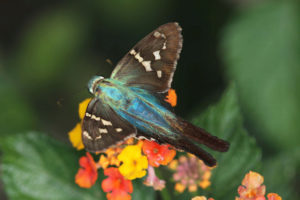Wildlife Wednesday: Native Bees of Houston
When most people think about bees, they think about honeybees, a species of bee that was introduced to the U.S. from Europe. Its one of the most numerous bees in the area, and if you have flowers in your garden, you’re likely to see many of them. However, honeybees aren’t the only bees that pollinate flowers around Houston. There are many more species of bees beyond honeybees, and many overlooked species of native bee that visit Houston gardens. Here, we’ll look at a few species of these native bees.
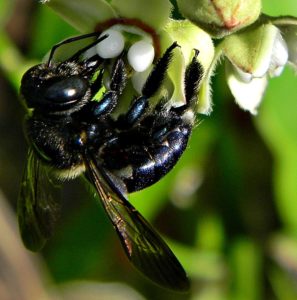 Eastern Carpenter Bees (Xylocopa virginica), pictured above, as the name would suggest, nest by chewing holes into dead wood on branches, logs, and sometimes the wood in human made structures. Here in the park, we’ve noticed them burrowing into picnic tables, the picnic pavilions, and the border pieces on the outside of the house. Though this may be vexing, they rarely cause serious damage to structures. Unlike, honeybees, they’re not truly eusocial (colonial) bees, but live in loosely knit groups, in which there is a dominant female. Unlike “queen bees” though, the dominant females are not the only reproducing females in their group. Some carpenter bees, like the Southern Carpenter Bee (Xylopcopa micans), pictured left, are considered “solitary bees”, living in only in mating pairs.
Eastern Carpenter Bees (Xylocopa virginica), pictured above, as the name would suggest, nest by chewing holes into dead wood on branches, logs, and sometimes the wood in human made structures. Here in the park, we’ve noticed them burrowing into picnic tables, the picnic pavilions, and the border pieces on the outside of the house. Though this may be vexing, they rarely cause serious damage to structures. Unlike, honeybees, they’re not truly eusocial (colonial) bees, but live in loosely knit groups, in which there is a dominant female. Unlike “queen bees” though, the dominant females are not the only reproducing females in their group. Some carpenter bees, like the Southern Carpenter Bee (Xylopcopa micans), pictured left, are considered “solitary bees”, living in only in mating pairs.
While carpenter bees are large round bees, they are not bumble bees, which are in a different family. You can tell the difference by looking at the abdomen, which is bare on carpenter bees (look left) and furry on bumble bees (look down and to the right).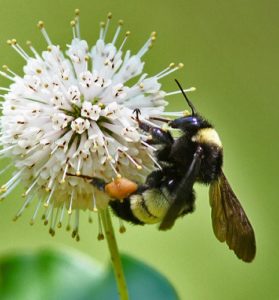
American Bumblebees (Bombus pennsylvanicus) are wide ranging fat fuzzy bees that can be seen flying slowly from flower to flower. Like carpenter bees, they are often too large to fit into some flowers to feed on nectar, and will “nectar rob”, chewing into the base of the flower to get at the nectar, without coming into contact with the pollen. Regardless of this occasional behavior, bumblebees are important and numerous pollinators for a wide variety of native flowering plants. The American Bumblebee is colonial, often excavating burrows in the ground and under logs and rocks, but have a more variable and changing social structure than that of honeybees.
The American Bumblebee, like many species of bumblebee, is declining in numbers, due to habitat loss and overuse of pesticides, especially neonicotinoids.
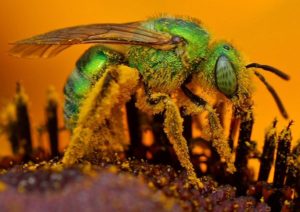 Metallic Green Bees (Agapostemon spp.), with their shiny green exoskeletons, are rather conspicuous when they visit a flower. Some are completely green, while others are green in the front with a yellow striped abdomen. They are in the Sweat Bee family, Halictidae, so named for their habit of occasionally landing on humans and drinking their sweat, which can be a welcome source of salts and other nutrients for bees (some butterflies, flies, and small beetles do this as well). Metallic Green Bees live communally in underground burrows. Each mating pair has its own separate burrow, where they raise their young, but the burrows are all close together, which helps with defense against predators and parasites.
Metallic Green Bees (Agapostemon spp.), with their shiny green exoskeletons, are rather conspicuous when they visit a flower. Some are completely green, while others are green in the front with a yellow striped abdomen. They are in the Sweat Bee family, Halictidae, so named for their habit of occasionally landing on humans and drinking their sweat, which can be a welcome source of salts and other nutrients for bees (some butterflies, flies, and small beetles do this as well). Metallic Green Bees live communally in underground burrows. Each mating pair has its own separate burrow, where they raise their young, but the burrows are all close together, which helps with defense against predators and parasites.
Sweat bees, which are generally small bees, are important pollinators for smaller flowers, which larger bees may ignore.
Thanks for joining us this week, to learn more about some of our native bees. If you don’t find these animals in your own garden, take a trip out to the nature center sometime, and visit our native wildflower gardens or our Pocket Prairie.
See you soon!
Eric Duran
Staff Naturalist
~ Many species of our native bees are in trouble, because of development and overuse of pesticides. You can help by planting native and wildlife friendly flowers, leaving some space for ground nesting bees, and not using neonicotinoid pesticides.
To find out more about how you can help bees, visit: https://xerces.org/bumblebees and https://www.fws.gov/pollinators/pollinatorpages/yourhelp.html
photographs: Eastern Carpenter Bee by Daniel Schwen | Wikipedia; Southern Carpenter Bee by Bob Peterson | Wikipedia; American Bumblebee by Diana Terry Hibbits | EOL; Metallic Green Bee by Jon Sullivan | Wikipedia
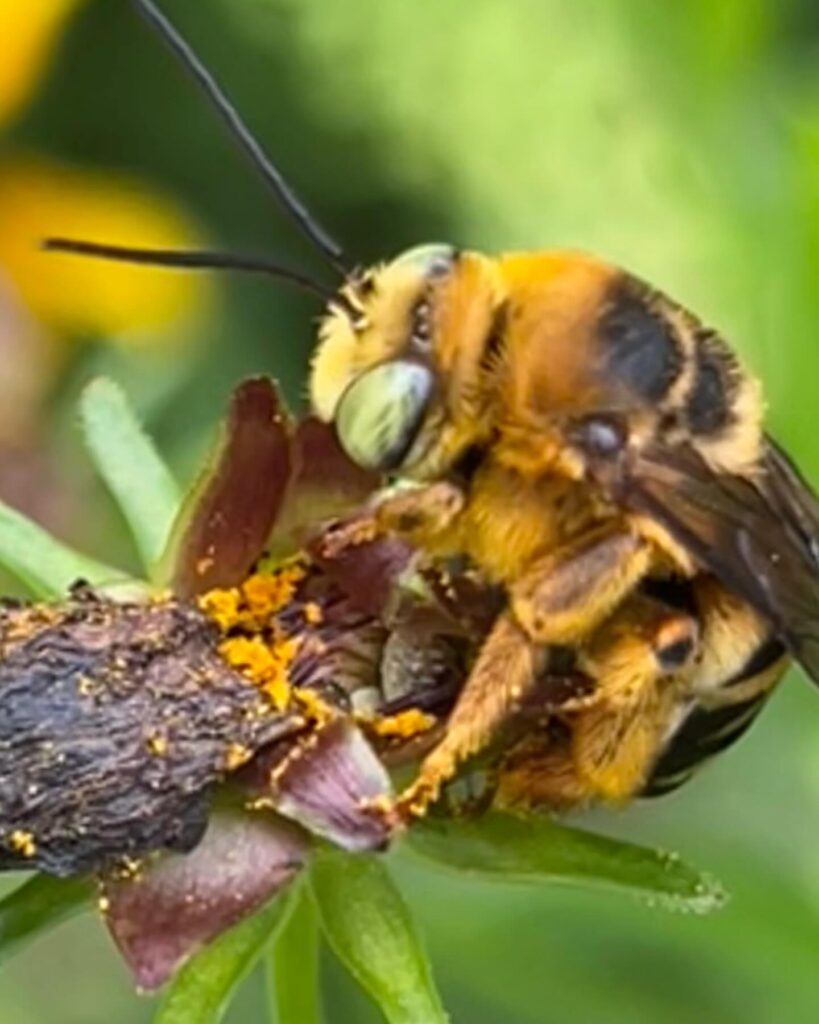



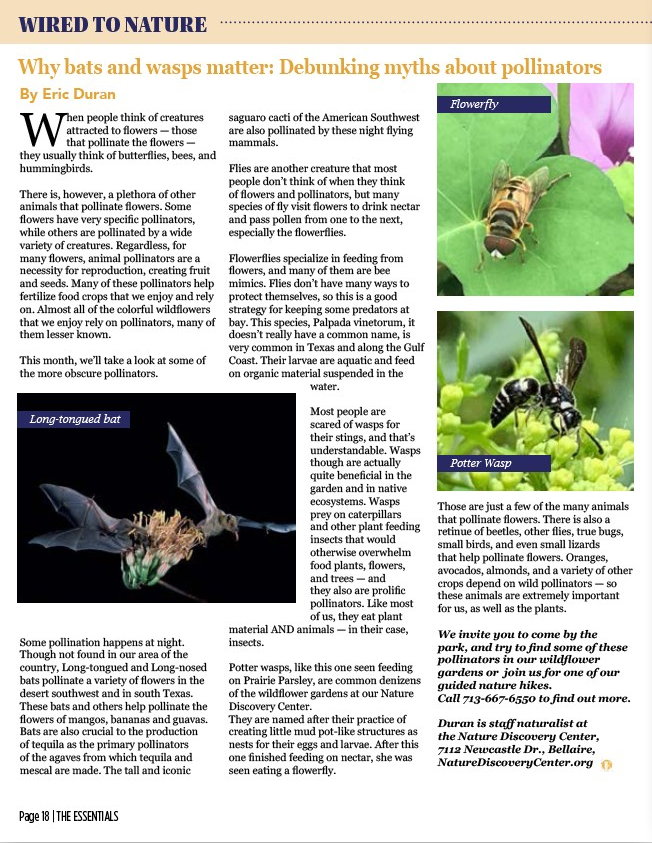
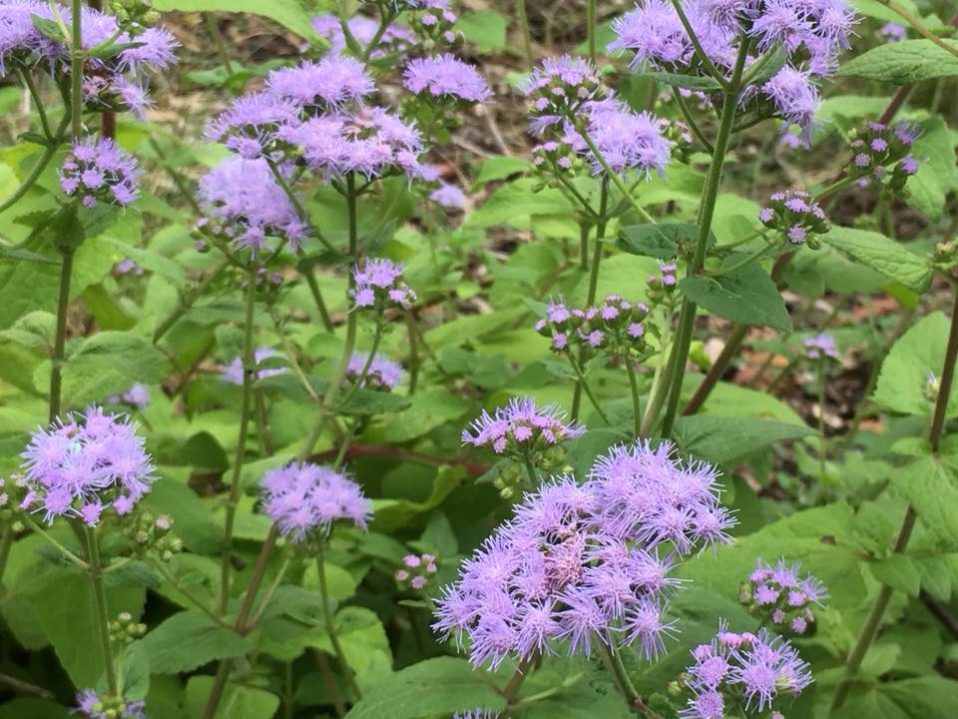
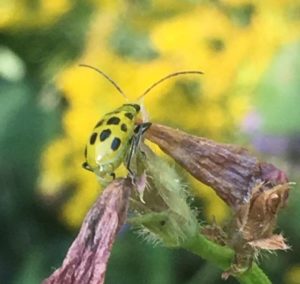 People don’t usually think of beetles as pollinators, but we’ve recently found Spotted Cucumber Beetles (
People don’t usually think of beetles as pollinators, but we’ve recently found Spotted Cucumber Beetles (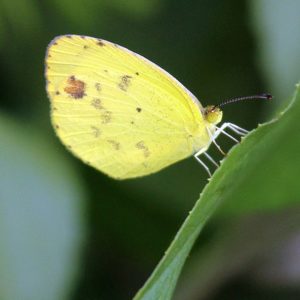
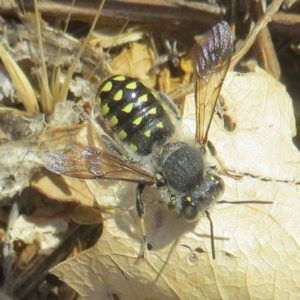 Wool Carder Bees (Anthidium maculosum) are solitary bees, and are just a bit shorter than honeybees, but thicker-bodied. Unlike honeybees, the males males are larger than the females and territorial, and they survive after mating. The females mate with various different males, and establish a nest to lay eggs and raise young by themselves. They are referred to as “carder bees”, because of their habit of gathering plant hairs and fibers to construct their nests.
Wool Carder Bees (Anthidium maculosum) are solitary bees, and are just a bit shorter than honeybees, but thicker-bodied. Unlike honeybees, the males males are larger than the females and territorial, and they survive after mating. The females mate with various different males, and establish a nest to lay eggs and raise young by themselves. They are referred to as “carder bees”, because of their habit of gathering plant hairs and fibers to construct their nests.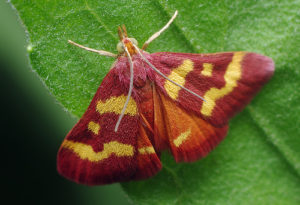
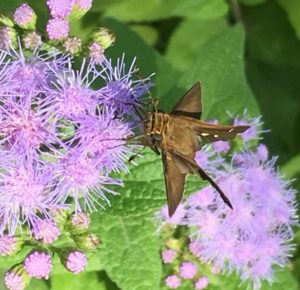 Well, we hope you enjoyed our mini review of some of the insects that have been visiting our Mistflower, here at the Nature Discovery Center. Also, we hope you will consider this beautiful and robust plant for your own home garden, both as decoration and food for wild pollinators.
Well, we hope you enjoyed our mini review of some of the insects that have been visiting our Mistflower, here at the Nature Discovery Center. Also, we hope you will consider this beautiful and robust plant for your own home garden, both as decoration and food for wild pollinators.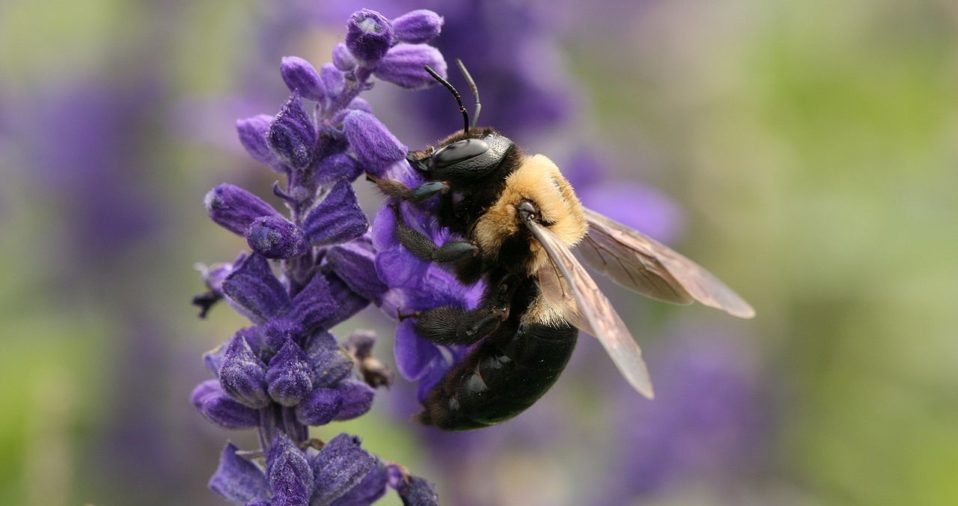



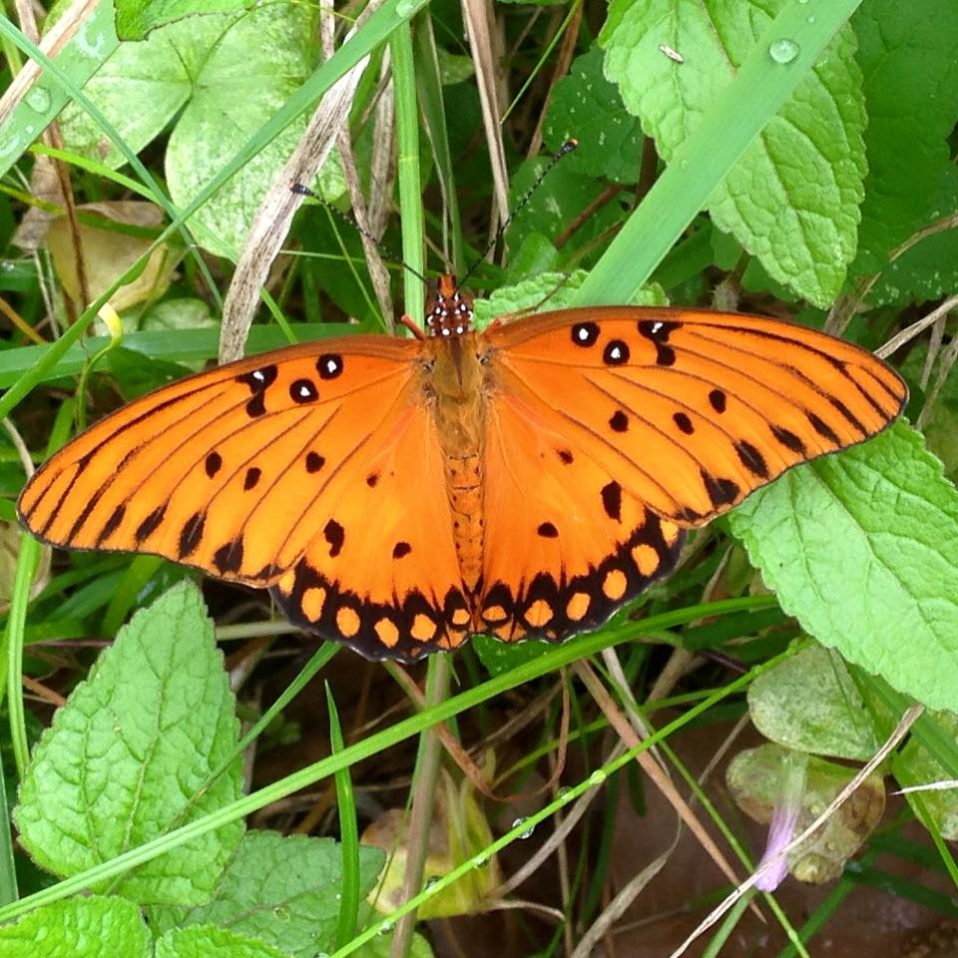
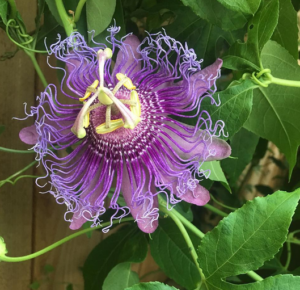 one of our most common butterflies in the park. Not actually related to other fritillaries, these butterflies are actually a kind of longwing or Heliconian butterfly. While the adults will feed on nectar from a variety of flower species, the larvae (caterpillars) will only feed on passionvines (Passiflora spp., Left photo). Passionvine leaves are toxic, and in turn the caterpillars are toxic, as are the adults. The bright orange and black coloration acts as a warning. Gulf Fritillaries have a wingspan of about 3.5 inches.
one of our most common butterflies in the park. Not actually related to other fritillaries, these butterflies are actually a kind of longwing or Heliconian butterfly. While the adults will feed on nectar from a variety of flower species, the larvae (caterpillars) will only feed on passionvines (Passiflora spp., Left photo). Passionvine leaves are toxic, and in turn the caterpillars are toxic, as are the adults. The bright orange and black coloration acts as a warning. Gulf Fritillaries have a wingspan of about 3.5 inches.
